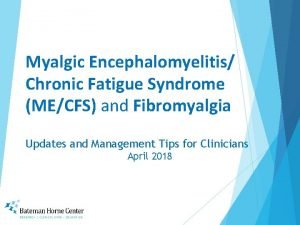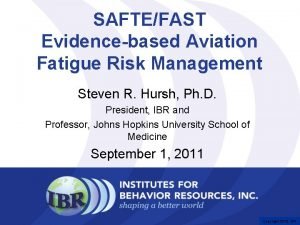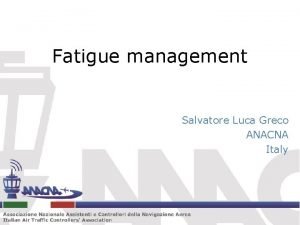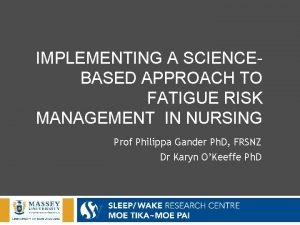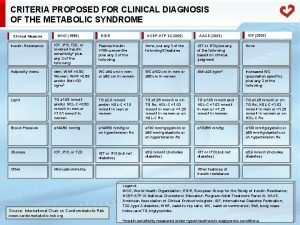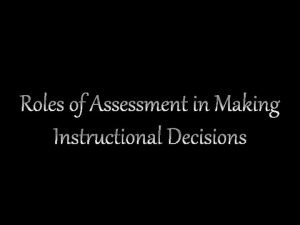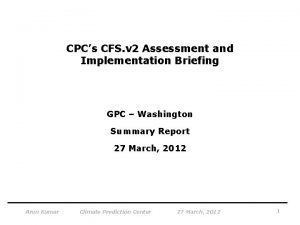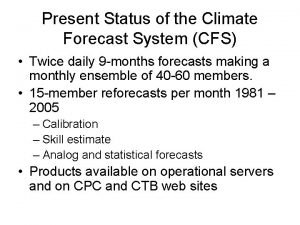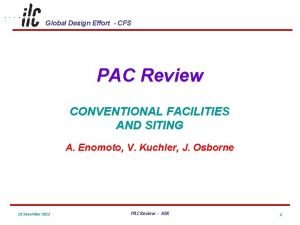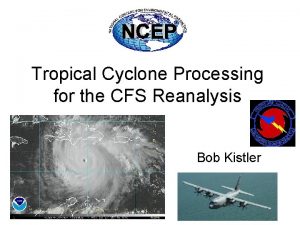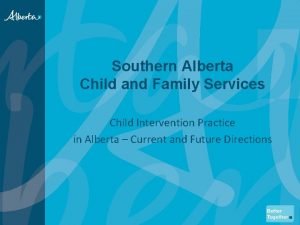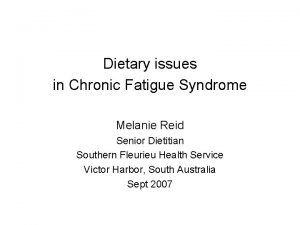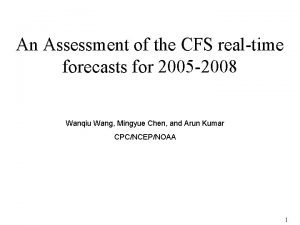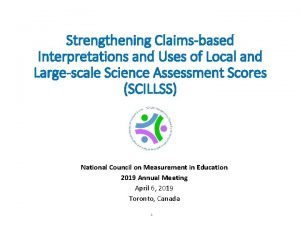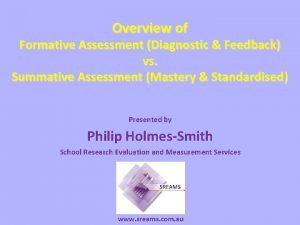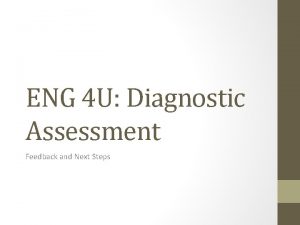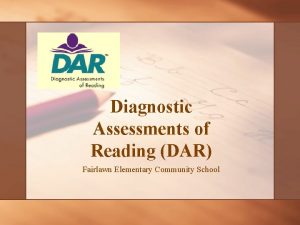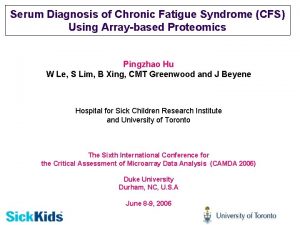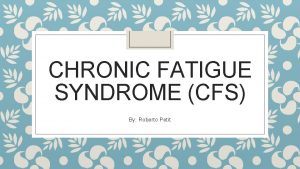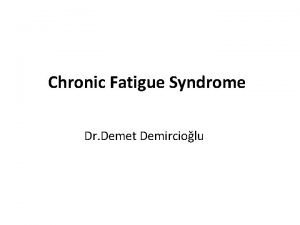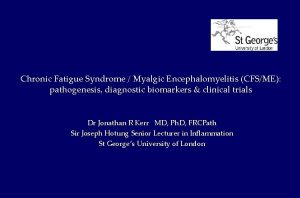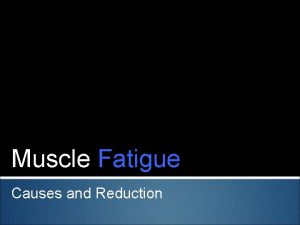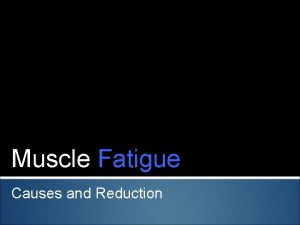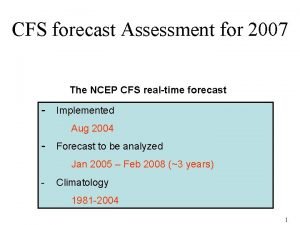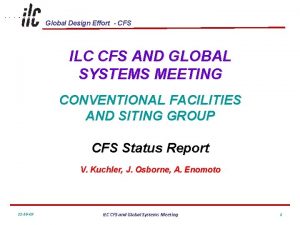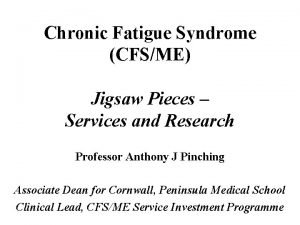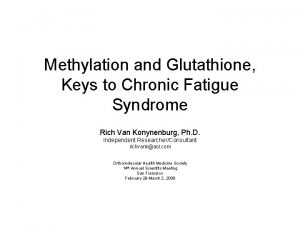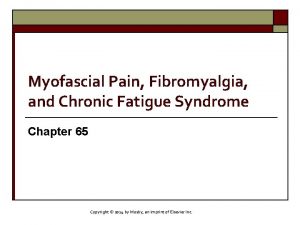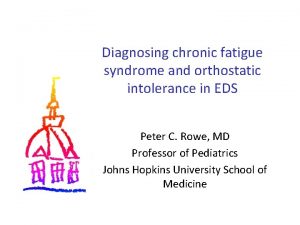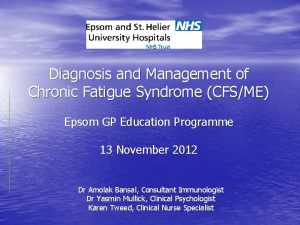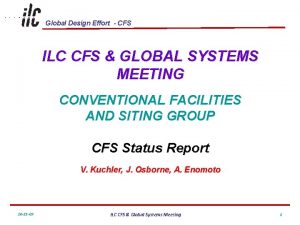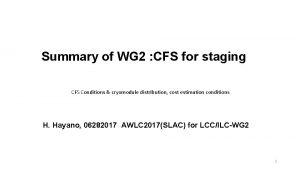CHRONIC FATIGUE SYNDROME CFS DIAGNOSTIC AND ASSESSMENT ISSUES

![Case Definition [C. D. C. , 1994] A) Clinically evaluated, unexplained persistent or relapsing Case Definition [C. D. C. , 1994] A) Clinically evaluated, unexplained persistent or relapsing](https://slidetodoc.com/presentation_image_h2/aaad1efc346511f912b3509543af521c/image-2.jpg)
![Case Definition [C. D. C. , 1994] • B) Four or more of the Case Definition [C. D. C. , 1994] • B) Four or more of the](https://slidetodoc.com/presentation_image_h2/aaad1efc346511f912b3509543af521c/image-3.jpg)



























- Slides: 30

CHRONIC FATIGUE SYNDROME (CFS) DIAGNOSTIC AND ASSESSMENT ISSUES
![Case Definition C D C 1994 A Clinically evaluated unexplained persistent or relapsing Case Definition [C. D. C. , 1994] A) Clinically evaluated, unexplained persistent or relapsing](https://slidetodoc.com/presentation_image_h2/aaad1efc346511f912b3509543af521c/image-2.jpg)
Case Definition [C. D. C. , 1994] A) Clinically evaluated, unexplained persistent or relapsing chronic fatigue ( 6 months duration) that is of new or definite onset (has not been lifelong); is not the result of ongoing exertion, is not substantially alleviated by rest; and results in substantial reduction in previous levels of occupational, educational, social, or personal activities.
![Case Definition C D C 1994 B Four or more of the Case Definition [C. D. C. , 1994] • B) Four or more of the](https://slidetodoc.com/presentation_image_h2/aaad1efc346511f912b3509543af521c/image-3.jpg)
Case Definition [C. D. C. , 1994] • B) Four or more of the following symptoms are concurrently present for > 6 months: • 1. Impaired memory or concentration • 2. Sore throat • 3. Tender cervical or axillary lymph nodes • 4. Muscle pain • 5. Multi-joint pain • 6. New headaches • 7. Unrefreshing sleep • 8. Post-exertion malaise

Diagnostic Hints • Diagnostic based on inclusion and exclusion criteria • No pathognomonic signs or diagnostic tests validated in scientific studies • Must have persistent or relapsing, debilitating fatigue for at least 6 mo. • In the absence of any current or past medical condition that would explain the clinical presentation

A discrete clinical entity? This question raises 2 issues: • Usefulness of the diagnosis • Overlap with other clinical conditions

A discrete clinical entity? • CFS, Fibromyalgia, Irritable Bowel Syndrome or Idiopathic chronic Pain as associated disorders (Goldenberg, 1999) • a diagnostic label promoting illness behavior and exaggeration of the expression of disability and pain (Barsky and Borus, 1999)

A discrete clinical entity? • However a useful diagnosis: – reassures patients on the absence of a degenerative disease – allow patients to concentrate on getting better rather than getting a diagnosis and searching for a cause or a cure (Goldenberg, 1999)

A discrete clinical entity? • 90% of patients believed that a diagnosis of CFS was the most helpful factor in managing their symptoms (Hewett et al. , 1995) • CFS, FM, and TMD shared many clinical features (e. g. , myalgia, fatigue, sleep disturbances, impairment in daily activities) (Aaron et al. , 2000)

A discrete clinical entity? • Frequent co-morbidity among CFS, FM, and TMD patients (e. g. , 35 to 70% patients with CFS also had FM) • A stress-related illness, with onset related to acute or chronic emotional stressors, or to a combination of emotional and physical events (Demitrack & Crofford, 1998)

Differential Diagnosis Considerable phenomenological overlap with other functional somatic syndromes Therefore a discussion of a common set of psychosocial factors applies to all of them (Barsky and Borus, 1999)

Differential Diagnosis CFS and Depression • CFS might be a variant of a neuropsychiatric disorder, such as major depression (Brickman and Fins, 1993) • Frequent comorbidity observed in the population of CFS patients (Goodnick, 1993) • Issue of directionality (cause or effect)

Differential Diagnosis CFS and Depression • Shared symptoms: - persistent fatigue - pain - sleep disturbance - poor concentration - psychomotor retardation - loss of sexual desire (Friedberg & Jason, 2001)

Differential Diagnosis CFS and Depression • CFS more debilitating than depression • More severe neurocognitive symptoms in CFS (e. g. , memory and concentration, mental confusion) • Symptoms less likely to be reported in primary depression (e. g. , painful lymph nodes, flu-like symptoms, pressure-like headaches, alcohol intolerance)

Differential Diagnosis CFS and Depression • Key distinction: Postexertional malaise and prolonged fatigue after exercise - atypical in primary depression (often mood elevation with exercise) (Moor & Blumenthal, 1998)

Differential Diagnosis CFS and Depression • Loss of interest (Depression) vs. Loss of ability (CFS) Ask for 5 things they want to do • Cognitive differences: - CFS: more likely to endorse tendencies to dwell on fatigue - Depression: thoughts of worthlessness, self-criticism, suicidal ideation more common

Differential Diagnosis CFS and Somatization Disorder (SD) • Differences in onset: - CFS: often sudden onset, late 20’s/early 30’s - SD: progressive, starting in adolescence, full-blown somatization by 25 • Medically unexplained symptoms in both hard to delineate

Differential Diagnosis CFS and Anxiety • CFS often accompanied by persistent anxiety • Focus on prominent feature to distinguish GAD from CFS: - CFS: severe fatigue - GAD: excessive persistent anxiety, not necessary w/pain or profound fatigue (treated w/CBT)

Differential Diagnosis CFS and Activity-Induced Chronic Fatigue • 2 types of CFS patients: - severe post exertional fatigue, slightly alleviated by rest - severe overall symptomatology, severe postexertional fatigue, fatigue not alleviated by rest • Healthy people: persistent fatigue due to active schedules, high stress, lack of sleep – remission of symptoms with increase in rest and leisure time

Hypotheses to account for CFS • Functional somatic syndrome Barsky and Borus (1999); Sharpe and Wessely (1997) • Abnormalitites in immune functions Klimas et al. (1990, 1994); Patarca et al. (1993) • Viral etiology of CFS Jones et al. (1985); Straus et al. (1985) • Perturbations of the HPA axis function Demitrack et al. (1991) • Brain stem hypometabolism Buskila (2000)

Physiological abnormalities in CFS • researchers have extensively tested for: - immune status - infectious agents - disorders of the endocrine or central nervous systems • No need for such testing in practice unless as part of a protocol-based research study or when the diagnosis is in question

Explanatory Models of CFS • Immune defect Model • Sleep disturbance Model • Neuroendocrine Abnormalities • “Predisposing Personality” Model • Symptom Avoidance Model

The Mind & Body Approach • Assessed and Treated in a nonspecific manner • But integrated medicalpsychiatric approach the clinical assessment and care of functional somatic syndromes • Intervention model based on 4 axes

A Multidimensional Model • Distinguishes: - Predisposing factors - precipitating factors - perpetuating factors (Demitrack & Crofford, 1998)

A Conceptual Framework and set of Guidelines • Need for a comprehensive, systematic, and integrated approach to the evaluation, classification, and study of people with CFS or other fatiguing illnesses (Fukuda et al. , 1995)

A Conceptual Framework and set of Guidelines • Need for revised criteria to define CFS • Need for clinical evaluation standards • Definition and Clinical evaluation of Prolonged and Chronic fatigue

A Conceptual Framework and set of Guidelines • Prolonged Fatigue Self-reported, persistent fatigue of 1 month or longer • Chronic Fatigue • Self-reported, persistent or relapsing fatigue of 6 or more consecutive months

A Conceptual Framework and set of Guidelines • Clinical Evaluation To identify underlying or contributing conditions that require treatment For further diagnosis or classification of chronic fatigue cases

A Conceptual Framework and set of Guidelines Areas to include in evaluation: • History of medical and psychosocial circumstances at onset • Mental status Exsamination • Physical Examination • Minimum battery of lab screening tests

Conclusion • Specific and non-specific assessment: standard tools and customized clinical interview • Biopsychosocial Approach • Mastery of Case Definition Criteria • Diagnostic reevaluation based on initial treatment response

Conclusion • Challenging diagnosis and treatment that will benefit from continuous research and education of primary health care providers • Importance of experience with this specific population – requires special training (CEU)
 Myalgic encephalomyelitis
Myalgic encephalomyelitis Chronic coronary syndrome
Chronic coronary syndrome Fatigue assessment tool
Fatigue assessment tool Sleep wake cycles
Sleep wake cycles Fatigue risk assessment matrix
Fatigue risk assessment matrix Diagnosis of insulin resistance
Diagnosis of insulin resistance Diagnostic vs summative assessment
Diagnostic vs summative assessment Pinnacle lgs
Pinnacle lgs Cfs version 2
Cfs version 2 Cfs saigonnewport
Cfs saigonnewport Cfs
Cfs Cfs vaccine
Cfs vaccine Reforecast past tense
Reforecast past tense Cfs
Cfs Cfs firstnet
Cfs firstnet Cfs
Cfs Cfs jebel ali
Cfs jebel ali Cfs
Cfs Energy star commercial kitchen equipment calculator
Energy star commercial kitchen equipment calculator Cfs format
Cfs format Cfs reanalysis
Cfs reanalysis Southern alberta child intervention services
Southern alberta child intervention services Mutaflor cfs
Mutaflor cfs Cfs nice guidelines
Cfs nice guidelines Cfs forecast
Cfs forecast Formative assessment
Formative assessment Assessment formative summative diagnostic
Assessment formative summative diagnostic Diagnostic feedback examples
Diagnostic feedback examples Leap 360 diagnostic
Leap 360 diagnostic Leadership diagnostic assessment
Leadership diagnostic assessment Dar reading assessment
Dar reading assessment
